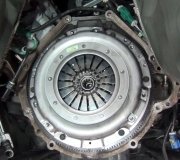Friday, February 24th, 2012 AT 4:06 PM
I would like to know how the ECM activates the torque converter lockup. There are 2 wires going to the lockup solenoid at the front of the transmission, a purple and a brown/black. If I put power to one and ground the other there is no draw if the vehicle is not running, but if it is running at the speed the lockup would normally engage it blows a 20 amp fuse. This does seem to indicate that the circuit is somehow switched witin the transmission to allow lockup only at the correct time. What I don't understand is how the solenoid is activated through thses 2 wires unless there are wires to the transmission somewhere else that I am not a ware of. If these are the only 2, I should be able to activate the solenoid by duplicating what the ECM does. The lockup was taking a long time to attempt to engage and then was going in and out. It did not blow fuses however. I am trying to understand how this setup works so that by manually attempting to engage it I can determine if the problem is at the solenoid end(then I would get the same reaction as it has been doing when driven) or the signal end( then if I manually activated it it would work properly). Please tell me specifically how the solenoid is activated. Thank you so much for your help!


